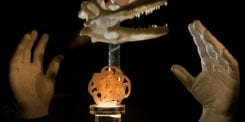On the case with the blood detective
UCI hematologist Dr. Jae Chang employs medical sleuthing skills to identify rare blood disorders.

“Blood’s a funny thing. It tells a story.” – “CSI: Miami”
October 2003: A Barstow man struggling to breathe was airlifted over the San Bernardino Mountains to UC Irvine Medical Center. On-site physicians quickly determined he had acute respiratory distress syndrome (ARDS) – his lungs were not providing enough oxygen to the blood – but they didn’t have a clue why.
So they contacted Dr. Jae Chang, blood detective. “Give me 24 hours to see what I can do,” he remembers saying.
A UCI hematologist, Chang specializes in treating patients with complex and hard-to-diagnose blood disorders, the kind requiring the experience, intellect and well-trained eye of a grizzled crime-scene investigator.
He says that with blood disorders, it isn’t readily apparent why someone is ill. The key information is hidden deep in the cells. “Looking for a diagnosis is like a detective searching for clues,” he adds. “And if you don’t have the proper diagnosis, you cannot save a life.”
Chang examined the patient – gasping for every breath, skin ashen – and began to suspect the man had hypoxia, a state of oxygen deficiency that can shut down organs. He took a blood sample and dropped it on a slide; he needed to probe further.
Peering through his microscope, Chang saw something in the Barstow man’s blood cells that recalled a case years earlier. That patient also had ARDS. The cause? Thrombotic thrombocytopenic purpura, or TTP, a very rare disease that destroys red blood cells, thereby limiting the amount of oxygen fed to the body. Chang was among the first to discover that TTP can alter normal lung function and trigger the onset of ARDS, and he was sure it was the culprit this time.
“I knew what to look for,” he says. “But TTP is not a condition that’s obvious to other doctors, and it cannot be detected by any standard types of testing.”
With this diagnosis, Chang convinced the attending physicians to let him administer an unconventional treatment for ARDS – plasma exchange therapy, which is the treatment of choice for TTP. “I knew if I was right, it would be evident within 36 hours,” he says.
After a day and a half, the patient’s condition began to improve. Weeks later, the man was discharged from the hospital TTP-free with no problems breathing and a big smile on his face. Case solved.
Chang has worked at the Chao Family Comprehensive Cancer Center since 2003, treating leukemia and other blood cancers as one of 14 doctors in UCI’s Division of Hematology/Oncology. But he’s among Southern California’s few specialists in rare blood diseases, and many of the region’s most complex cases are referred to him.
“Dr. Chang is one of a select breed,” says Dr. Randall Holcombe, hematology/oncology chief. “He’s very well respected for his clinical acumen, and he’s been an unbelievable resource for us.”
Some of his cases could be the basis of a reality TV show – or a memoir, which Chang plans to write someday. He recalls one individual admitted with a strange bleeding problem that was traced to rat poison.
Another patient had been suffering for 16 years from jaundice, which is due to elevated levels of bilirubin, a chemical formed by the breakdown of red blood cells. But what caused the excessive bilirubin? Chang ID’d it as Crigler-Najjar Syndrome Type II, a genetic disorder found in only a few hundred people worldwide.
“I’ve seen lots of strange and rare cases,” he says. “Blood is complicated; it can have many diseases. I’ve always wanted to be a blood specialist — it’s endlessly fascinating. I can’t imagine doing anything else.”


